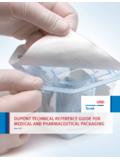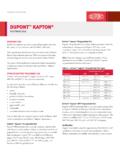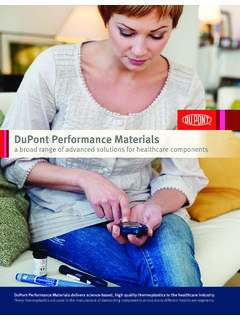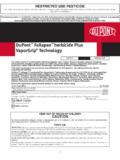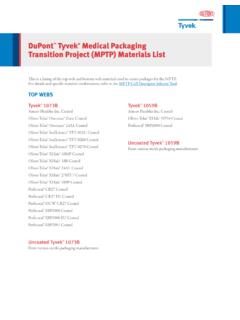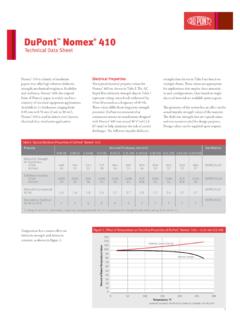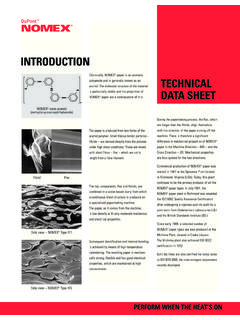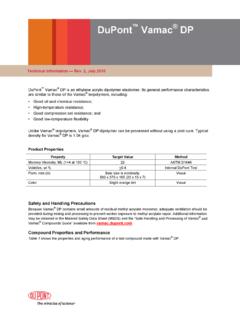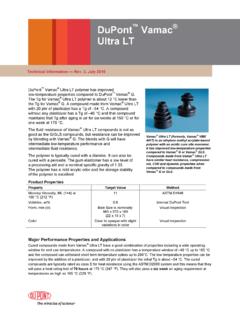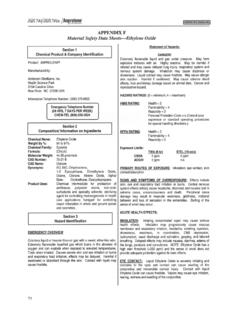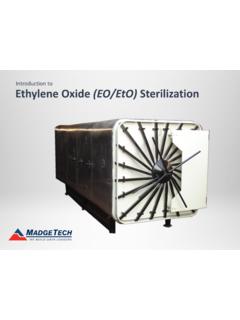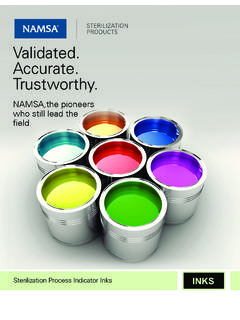Transcription of The effect of common sterilization techniques on …
1 du pont de Nemours Intl. SA, PO Box 50, CH-1218 Grand Saconnex 1 Authors: Teresa Rodon, DuPont UK Ernst Poppe, DuPont INTL SA Alexandra Fabbro, DuPont INTL SA Tom Baltus, DuPont Canada Co. July, 2010 The effect of common sterilization techniques on the mechanical properties of DuPont Performance Polymers Special Control (SC) and Premium Control (PC) grades Index 0. - Summary 1. - Introduction of sterilization 2. - sterilization Methods - Steam - Ethylene Oxide - Radiation - Dry Heat - Plasma 3. - General Considerations of Polymers for sterilization 4. - Results of sterilization on DuPont Engineering Polymers - sterilization effects on Physical Property Retention - Steam sterilization - Gamma - E-beam - EtO 5. - Conclusions 6. Disclaimer du pont de Nemours Intl.
2 SA, PO Box 50, CH-1218 Grand Saconnex 2 0. - Summary DuPont Performance Polymers offer resins for components in medical devices. Certain single-use devices undergo one sterilisation process whilst others designed for multiple-use, must be sterilized several times. It is vital to ensure that the sterilisation process does not affect the material properties but is successful in destroying microbes. This study was devised in order to predict the behaviour of DuPont Special Control and Premium Control grades following sterilization by methods that are often used in the healthcare industry. Due to their good thermal stability and excellent chemical resistance, engineering polymers can withstand most sterilization processes. An overview is given in the table below: 1.
3 Introduction Medical devices may be classified into 3 categories as follows: A non-critical device where the device has a limited surface contact with non damaged skin, A semi-critical device where the device has direct contact with tissues or damaged skin, A critical device which penetrates the skin, or the mucosa during use and which gets in direct contact with blood, tissues, organs and trauma Depending on the above described category, appropriate sterilization of these medical devices will be an essential step in the manufacture of healthcare products to ensure both their shelf-life and reliability when in use. It is a challenged process of the highest order used to render a product free of all forms of viable micro-organisms. 1 1 Wayne Rogers, sterilization of Polymer Healthcare Products , Rapra Technology Ltd.
4 du pont de Nemours Intl. SA, PO Box 50, CH-1218 Grand Saconnex 3 sterilization may be defined as the inactivation or destruction of viable micro-organisms. ISO 11135:1994 defines sterility as State of being free from viable micro-organisms . 2. - sterilization Methods There are few agents capable of sterilizing polymer components. Typical methods are: Steam Ethylene oxide (EtO) Radiation (Gamma, Ebeam) Dry Heat Plasma - Steam sterilization Steam sterilization , or autoclaving, is a widely used method. It can be performed with relatively low-cost equipment using saturated steam. The process is robust, easy to control, safe and environmentally friendly. Typical process conditions are 20 min at 121 C or 5 min at 134 C. The limiting factor for many standard polymers is their heat resistance (Tg, dimensional stability), particularly for single-use devices, and their hydrolytic resistance in the case of multiple sterilisation cycles.
5 - Ethylene Oxide sterilization (EtO) EtO sterilization is a gaseous method involving the highly diffusive, permeable and toxic EtO gas. This destroys bacteria and other micro-organisms. Due to the nature of the process it is particularly suitable for medical devices containing electronic components. This technique requires thorough process control to eliminate any residuals on the sterilized components. Well trained personnel and safe practices during operation are required to avoid any leakage of this flammable, explosive, carcinogenic gas. Typical EtO sterilization processes involve several stages of gas removal; humidification, EtO exposure and air washes. Process pressures are close to vacuum and temperatures used are around 50 C. Most plastic materials are compatible with EtO sterilization .
6 - Radiation Radiation is a type of cold sterilization . Gamma sterilization sterilization by gamma radiation uses the radioisotope Cobalt 60 as its energy source. Once formed, Cobalt 60 instantly begins to decay, releasing energy in the form of gamma rays. The artificially activated Cobalt 60 pellets are encapsulated in stainless steel pencils held in a source rack. To deliver the sterilization dose the source rack is raised from a deep pool of water and the product is passed around this radiation source on a conveyor system. The energy emitted is insufficient to induce radioactivity in any material, irrespective of the length of exposure to the source. Sterilising products by gamma radiation is a sophisticated process requiring extensive knowledge of the kinetics of microbial inactivation, polymer selection and process controls.
7 Gamma Irradiation possesses excellent penetrative capability. The unit of absorption is the Gray, expressed in kGy. This absorbed dose is impacted by product density, pack size, dose rate, exposure time and to some degree by part design. The main disadvantage associated with gamma irradiation concerns the potentially damaging effects of gamma rays on the product, particularly those products that contain polymeric components. Another drawback with this technique is the bulky shielding required to store the radioisotope. du pont de Nemours Intl. SA, PO Box 50, CH-1218 Grand Saconnex 4 Electron Beam sterilization using an Electron Beam involves emitting electrons from a heated tungsten filament gun and accelerating them down an evacuated tube.
8 This beam then passes through an oscillating magnetic field which scans it back and forth across the sample ensuring a uniform dose of radiation. The e-beam process achieves lethality using ionising radiation which acts on cellular constituents in a similar manner to Gamma radiation. E-beam sterilization has a number of advantages over gamma irradiation including its ability to be switched on and off at will, greater product compatibility and potentially very high throughput. Disadvantages include higher machine complexity and poor material penetration. In addition, validation and control of this technology is more demanding. - Dry Heat Dry Heat sterilization is generally conducted at 160 C-170 C for a minimum of two hours. Specific exposures are dictated by bioburden concentrations and temperature tolerances of the products.
9 Appropriate conditions will enable complete sterilization of the material. The equipment required is forced-air type ovens with temperature monitoring capabilities. This type of sterilization is highly dependent on the temperature resistance of the polymer. - Plasma Plasma is a gas in which a certain portion of the molecules are ionized. Different gases can be used, but Hydrogen Peroxide is most commonly used in this methodology. The process is easy to use, is safe, and can be considered as an alternative to the EtO method but it is more expensive. It is typically used where devices cannot handle high sterilization temperatures. 3. - General Considerations of Polymers for sterilization Designers of medical devices require multiple skills to ensure safe and reliable components for healthcare applications.
10 In addition to their medical engineering capabilities they need to be experts in function integration to enable component cost to be minimized and they also require advanced material knowledge for the appropriate polymer selection. In most projects the sterilization method is already known at an early stage. Therefore, it is necessary to check the polymer material candidates resistance to the selected sterilisation method upfront, which will help avoid any surprises during the later stages of device development. du pont de Nemours Intl. SA, PO Box 50, CH-1218 Grand Saconnex 5 4. - Results of sterilization on DuPont Engineering Polymers For the purpose of the study, ISO 2BA tensile bars (thickness = 2mm) were moulded and submitted to sterilization .
